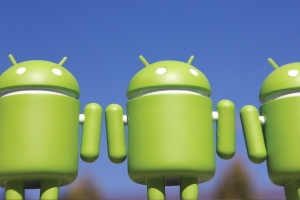Ladies and gentlemen I present the future of The Boob Tube: we shift from our cable boxes and laptops to…
HDTV viewing driven by words you search via your exo-brain (you need to stop calling it a phone, or else it’s going to get a complex). Yes your phone is your remote, and your television is your monitor. It’s going to happen just a bit slower I’d like, but *BAM* before you know it… you’ll forget I predicted it today because it will be as common as your toaster and microwave (note the lack of a hybrid toasterwave). I’ll thank you, dear WVFF back-rower, for reminding me of my psychic abilities next year.
Mac had a shot with the omni-present iPhone and the affordable AppleTV, but kinda blew it. The AppleTV wasn’t poised as a companion device to the phone, and that was its tragic flaw. Likewise it’s all so damned exclusive. Now the Android plus GoogleTV? That’s a game changer, friends. Let those green little robots march into my heart.
Before we examine some bold interim solutions, let me be “authentic” and “transparent” and disclose my biases. We have a home full of Macs. Two desktops, three laptops, two iPhones, three iTouches, one iPad, two old-style AppleTVs and one new one. And that’s not counting the Mac Mini and older desktops that are taking up closet space. As my debt can attest, the Apple bastards have never given me a thing for free (so I try to conceal these toys in my videos where possible). But I theoretically want to see Mac win, and I’m not seeing it. Similarly I’m biased in favor of Google since I do make a non-trivial amount of income from YouTube advertising around the 4-6 million views I get monthly. But I’ll try to be impartial.
On the road to smartphone-driven television viewing:
- Roku, TiVo, AppleTV… they got us partially there. But none of these devices harness the power of man’s best friend (after dogs): the “phone.”
- Today one of the first Google Television products will be announced by Logitech. Junien Labrousse, Logitech’s Executive VP of Products, is holding an invite-only media event in NYC at 3:oo p.m., presumably to launch the highly anticipated Revue. Perhaps it will invite people to use their phones as a remote, but I doubt it.
- Anything’s got to be better than Sony’s remote-controlled television. Ian Douglas, Gadget Guru for the UK’s Telegraph, aptly suggested it was designed blindfold, in the 1980s (screen shot below courtesy of Engadget). The gamer in your family may love this, but it’s no flying automobile.

You may be surprised that I’ve written precious little about Google TV… simply because until now it’s all been hype and imagination. But three things changed in the past weeks:
- Dean Gilbert, who worked on GoogleTV, is now heading YouTube’s content partnerships. He’s joined by Robert Kyncl, former VP of content acquisitions from Netflix. That, to me, suggests that Google is poising to position YouTube on the new platform.
-

We mean no harm to your planet. Newsweek ran a Grisham-like story about how Android is leapfrogging iPhone on the “next big screen” we call smart phones. It’s an interesting article to read, even if you didn’t just watch the fascinatingly depressing “The Social Network” movie. Where there are lawsuits, there’s game-changing innovation… and Newsweek documents the mad rush of lawyers chasing this disruptive market changer.
- Finally, we’re getting a taste of the toys. Sony will certainly claim its role, and Logitech may sell a mess of boxes… like Roku or TiVo. Of course the toys aren’t nearly as important as the BIG change.
Friends, GoogleTV plus Android equals comfortable viewing of searchable content, not from overpriced remotes, but… the smart phone you wear like a wrist watch in the 1970s.
Take the brief GoogleTV tour and imagine how your television interface will change, where you’re no longer a prisoner of the horrendously archaic cable-TV boxes brought to you by lazy monopolies like Verizon Fios and Comcast. Man I just want to give a crotch shot to the entire cable industry separating studios/networks and my television set. You’ll see that the Dish Network will have a distinct advantage as this model spreads, and our relationship with the television will fundamentally change.
Have a look at Logitech’s non-viral, viral video, featuring a television set with an eye, two feet, and a desperation to be relevant again. Video consumption will shift back to the biggest monitor in the house (that $2000 HDTV collecting dust), and the device powering it won’t be a laptop… they’re too clunky and hot, even if they’re far harder to lose than the chewed-up remote control.
I knew my “future of online video” chapter of Beyond Viral (Wiley) would have a limited shelf life. Here’s what you can expect in the next 6-18 months.
- Short-Term Adoption Minimal: Near-term purchases of GoogleTV devices will be minimal, as the “unwashed masses” would use a TRS-80 with their televisions if their cable provider told them that’s what they get. I’d like to say THIS is the Christmas season where web-TV becomes mainstream like those magical moments of precious technology adoption… CD players, DVD players, GPS devices. But I’m tired of being over zealous on that prediction like I did in 2007, 2008 and 2009.
- I proclaim 2011 the “Year of Smart Phones Marrying TV Sets.” Later in 2011 we’ll cross the… oh I hate using the term… “tipping point,” where consumers will want to drive their giant monitors (television sets) using their “exo-brains” (Dilbert cartoonist Scott Adams), also called “smart phones.” Since the cable providers will sleep through this era like Blackberry snoozed the “smart phone” alarm clock, this will favor pairs of devices: iPad and AppleTV, Android phone and GoogleTV. I’m betting on the latter, and we’ll see Mac getting Microsofted and Microsoft buying anything that offers it a shortcut back to relevance. This TV/smart phone revolution should be especially interesting when we see “dueling banjos of remote controls” — between teenagers and their parents. Sure some will prefer to enjoy the tablet as a giant remote, but the kids have it occupied playing Angry Birds and Zombies versus Plants. Besides, it’s all covered with jam and peanut butter.
- Search will drive views… people won’t passively roam stations, getting stuck on “forebrain freezing” infomercials. Instead they’ll type the names of shows, actors, and even obscure strings of words like “knife, annoying, orange.” Where we once surfed stations, we’ll now search shows, actors and words… and remain mostly indifferent to where, when and how they appear. Sit with that thought for a moment… it’s kinda revolutionary.
- Even while search drives views, screen real estate will continue to influence us. Just as those “related videos” cause us to wonder into an online-video binge on YouTube… what GoogleTV does to serve related content will, in effect, possess us with a stronger hold than any television show or network. We may start our “television binge” with one intent, but the surrounding real estate will suck us into that comma-induced trance we love about today’s television.
- So… the more things change, the more they will stay the same. Still I’m going to bet that search-enabled consumers will democratize television. This gives independent content creators (especially those with existing audiences) a distinct advantage… at least until the big guys adapt to the medium.
Note: Added Oct. 7, 2010. Bobjenz predicted tablet/television combo on a guest post last year (see his post). When he pointed that out, I playfully edited his comment, which he didn’t find funny. Sorry, Bob. Note that Bobjenz also points out in that guest post the importance of regular uploads, which is perhaps my biggest and most tragic lapse over the past year.

